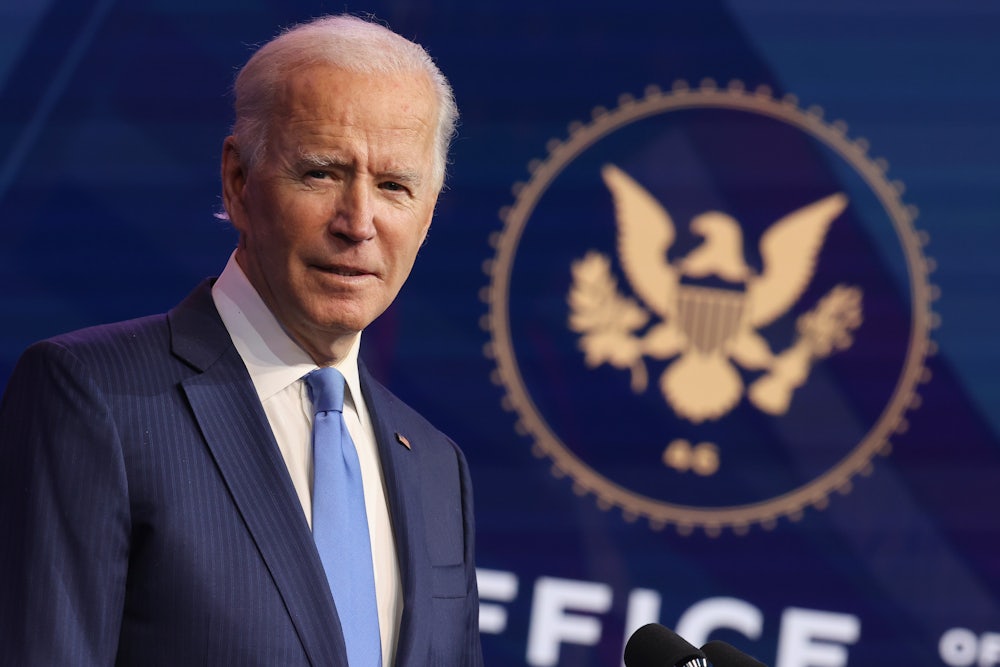Most Americans don’t give much thought to the “administrative state” in our daily lives. But the constellation of federal agencies and other institutions that translate public interest laws into concrete policies and programs is ever-present, humming in the background. This is true even as we grab food off store shelves without worrying about whether it will sicken our children or deposit our hard-earned money in banks, assured it will be there tomorrow—all thanks in part to America’s civil service.
Understandably, questions about the finer details of administrative process or regulatory design are simply too wonky and technical to register among our more pressing concerns. But that may soon need to change: President Joe Biden and the leading contenders for the Republican presidential nomination, such as Donald Trump and Ron DeSantis, have each set out very different visions for the kind of administrative state they hope to build. Whichever of these visions wins out could make the inner workings of these various agencies more immediately apparent to us all—and could dictate the future course of American democracy.
Antagonism toward the administrative state—and particularly the regulatory and public assistance programs it implements—has been an article of faith among conservatives for decades. Former Trump aide-de-camp Steve Bannon perhaps best captured this sentiment in February 2017 when he professed his desire to bring about the administrative state’s “deconstruction.”
While this commitment to deconstruction remains, conservatives’ attitude toward the administrative has evolved in complex ways that largely track with the conservative movement’s broader slide toward illiberalism. Inspired by the likes of Vladimir Putin, Viktor Orbán, and Jair Bolsonaro, conservative leaders now embrace a distinctly authoritarian form of government under the direct control of a nearly omnipotent president. They have come to view the administrative state—one that is both sufficiently weakened and shaped by unquestioned loyalty to the president—as key to implementing just such an authoritarian regime.
Influential right-wing think tanks as the Heritage Foundation and the Center for Renewing America—which was recently founded by Russell Vought, former Office of Management and Budget director under Trump—have been instrumental in the development of the right’s blueprint for an authoritarian administrative state. Among the latter organization’s major provisions is a plan based on a Trump executive order that would end America’s professional civil service as we know it. Fortunately, Biden rescinded the order on day one of his administration before it could be implemented, but it’s almost certain to resurface should a Republican nominee prevail in 2024.
This order purported to create a new classification within the federal government’s personnel laws known as “Schedule F,” which would have included all federal agency employees in “policy-related” jobs. Through this reclassification, tens of thousands of affected workers would have been stripped of standard civil service protections, effectively making them at-will employees. Hiring for these positions would also be exempted from the typical competitive process, making it easier to stock a broad swath of the federal bureaucracy with unqualified loyalists.
Other plays in the authoritarian administrative state playbook have been around much longer. One calls for extending presidential control over “independent” agencies—so called because Congress expressly designed them to be insulated against improper White House interference.
Another would revive a practice popularized by Richard Nixon known as “impoundment”—or the refusal to spend funds appropriated by Congress through the budget process. For instance, a future Republican president might reject funds intended to support environmental justice programs at the Environmental Protection Agency. Given that the U.S. Supreme Court has established fairly strict limits on impoundment, it seems this strategy is more wishful thinking than anything else—but the high court’s 6–3 majority has shown a penchant for blowing through established precedent when it suits their purposes.
More worrisome still are the kinds of “strong man” actions that cannot be comfortably packaged in slick policy papers. While on the campaign trail, DeSantis has made violent rhetorical attacks against public servants a part of his stump speech, even promising to “start slitting throats” once elected. And given what we know about Trump’s time in office, the possibility of a future Republican president abusively deploying federal law enforcement resources to harass or punish political opponents is simply too real to ignore. How far this might proceed under a scenario in which Schedule F is in place is difficult to predict—imagine the possibility of Trump’s political enemies not receiving their Social Security checks, and you’re starting to grasp the potential for harm.
There is another vision on the ballot in 2024. In a strong contrast with his likely GOP opponents, Biden sees the administrative state as a vital part of America’s constitutional democracy. And consistent with that concept, his administration has quietly instituted several reforms that would help bring the administrative state even closer to its full democratic potential.
Perhaps most noteworthy among them was a July guidance document that provides federal agencies with detailed instructions on how to “promote equitable and meaningful participation” by members of the public, especially those from structurally marginalized communities, in every step of the rulemaking process.
One of the major obstacles to public participation is that much of regulatory decision-making turns on highly complex matters of science, technology, and law. This is not to say that the unique “expertise” that lay members of the public can offer thanks to their situated knowledge and lived experience has no role to play even in these technical discussions. But as the guidance recognizes, public input—and especially the widely shared values it conveys—is particularly valuable at the earliest stages of the rulemaking process when priorities are being established and broad contours of potential policy responses are being explored.
Consideration of complex technical matters—which tend to be more second order in nature anyway—are more appropriately addressed at later stages of the rulemaking process. This sequential approach can thus be seen as a practical application of social philosopher John Dewey’s observation that “the man who wears the shoe knows best that it pinches and where it pinches, even if the expert shoemaker is the best judge of how the trouble is to be remedied.”
The guidance outlines several strategies for how agencies might better incorporate public input into priority setting and initial policy formation. Crucially, these strategies rely on affirmative outreach by agencies to potentially affected members of the public. This is a huge change from past practice, under which agencies generically invited public participation and passively received any input provided in response. Needless to say, this approach all but ensured that only the best-resourced and most sophisticated stakeholders would effectively engage.
The guidance also seeks to address the myriad material barriers that the public faces when trying to participate in the rulemaking process. Not everyone speaks English as a first language. Not everyone is comfortable expressing themselves in writing. Many rulemaking hearings take place on weekdays during standard businesses hours when most members of the public are at work. And for those rare hearings that take place outside of work hours, childcare commitments are yet another obstacle for working families.
Seeking to reduce the number of obstacles that ordinary people face when they want to participate in this vital aspect of civic life, the guidance directs agencies to do a better job anticipating these kinds of barriers and identify strategies for surmounting them. When an agency determines that a particular regulation is likely to affect a community that primarily communicates in a language other than English, it must work to translate relevant materials into that language. It encourages agencies to invite the public to submit their input in audio or video formats in addition to writing. Agencies must endeavor to schedule their outreach sessions at a variety of times to better accommodate people’s differing work and family obligations. The guidance even contemplates agencies offering childcare at their public meetings when legal authorities permit.
The Biden administration’s comprehensive approach to democratizing the administrative state has included other targets that might seem less obvious. For instance, as part of the Open Government National Action Plan it released last December, the administration announced several actions it was taking to “improve access to government data, research, and information.” As the plan notes, science is an increasingly central concern of the administrative state. Not only do public servant scientists conduct a significant amount of scientific research; they are also responsible for assessing and marshaling relevant scientific resources to inform policy. So greater transparency and expanded access to these activities will help empower the public to steer the research priorities of the public science enterprise. It will also help members of the public engage more effectively in the rulemaking process.
In addition, in April, Biden issued an executive order on “Modernizing Regulatory Review.” Since the early days of the Reagan administration, an obscure White House bureau called the Office of Information and Regulatory Affairs has reviewed agencies’ pending rules. The problem is that this process has tended to elevate technocratic economic considerations in regulatory decision-making to the point of overshadowing the widely shared public values—such as fairness and justice—that inspired the rules in the first place. That’s because, to survive these reviews, agencies had to defend their rules using a controversial analytical tool called cost-benefit analysis.
For example, the EPA has increasingly viewed its clean air regulations as an exercise in “correcting market failures” and in identifying “economically optimal” amounts of air pollution. Lost in the process are such considerations as whether these regulations will hold corporate polluters accountable and whether they are actually protecting the most vulnerable members in our community.
The new executive order begins the process of unshackling agency decision-making from this technocratic focus and therefore putting the “public” back into “public policy.” It gives agencies more freedom to account for noneconomic factors in their regulatory analysis, such as human dignity and racial justice. It also de-emphasizes the neoliberal goal of maximizing economic growth to allow for greater attention to the distributional effects of regulations—such that the benefits of regulation flow to those who need them most while the costs are borne by those who can best afford them.
Beyond concrete policy initiatives like these, the Biden administration has used its public platform to rebuild popular esteem for our administrative state. Its policy documents often include rich discussions about the regulatory system’s value for our democracy. And in contrast to DeSantis’s throat-slitting rhetoric, Biden’s OMB director, Shalanda Young, has been regularly updating a Twitter thread celebrating individual public servants and their contributions.
Importantly, a strengthened and publicly accountable administrative state such as the one the Biden administration is working to build doesn’t just uplift American democracy more broadly; it also serves as a crucial bulwark against future threats of democratic backsliding. We’ve already seen the invaluable role the professional bureaucracy played in preventing some of the Trump administration’s worst abuses of office. Indeed, it appears the success of our public servants—or what conservatives derisively refer to as the “deep state”—in thwarting many of Trump’s authoritarian ambitions is what is driving the right’s current campaign not just to deconstruct the administrative state but to retrofit it into some perverse version of itself, the better to pursue its illiberal goals.
With so much already riding on the outcome of next year’s presidential election, singling out the significance of the administrative state may seem bizarre and perhaps even a little absurd. Yet it may go a long way toward determining whether the American project of government “by the people” endures or perishes from the earth.










